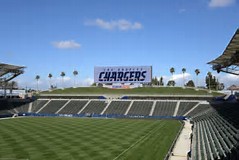The San Diego Chargers have always been one of my favorite NFL teams. Since joining the fledgling American Football League in 1960, the lightning bolt logo on the Chargers’ helmet came to symbolize a team that, for most of its storied history, was a high scoring machine which was capable of running up points in lightning-fast order. Quarterback legends John Hadl and Dan Fouts heaved long-distance bombs downfield to wide receivers like Lance “Bambi” Alworth and Charlie Joiner, while ferocious sack artists such as “Mean” Fred Dean from Louisiana Tech and linebacker Junior Seau played with abandon to thrill the San Diego faithful over the years.
Things changed after last season. The San Diego Chargers are no more. After years of haggling with the public sector over a new football stadium, Chargers’ owner, Alex Spanos, announced that he was bailing out of San Diego after 56 years and moving his NFL franchise to Los Angeles where he will now compete with the Los Angeles Rams for NFL fans and dollars. San Diego’s football stadium was constructed in 1967 and, despite a few major stadium upgrades, team ownership determined that they would either get a favorable deal for a new stadium or take their team to Los Angeles.
This, in itself, is quite curious. Los Angeles is actually the city where the Chargers were born in 1960. They lasted just one lonely season in Los Angeles and moved south to San Diego beginning in 1961. Those early San Diego Chargers teams, coached by the innovative Sid Gilman, were perpetually entertaining as the public address system blared a loud trumpet call to “Charge!” after every first down. San Diego’s team won an AFL championship in 1963 and, after joining the NFL in 1970, made it to one Super Bowl during the 1994 season, losing to the San Francisco 49ers.
As a television viewer, you could normally count on a beautiful day for a football game in San Diego with a stadium filled with vocal supporters. The team was generally competitive during its run in San Diego, making the playoffs in 18 seasons. San Diego isn’t a small market, either. It has nearly two million residents and is listed as America’s eighth largest city. So, why would anyone leave this city?
Answer – greed. The Spanos family, like others over the years, sees a market in nearby Los Angeles with three times the number of residents (higher local broadcast revenues) and a favorable stadium situation coming in a few years.
So, beginning this season and for at least three more, the Chargers have moved to Los Angeles and will play…in a 27,000 seat soccer facility named StubHub Center. How curious is it that the Chargers’ ownership would move their team from a 60,000 seat stadium in sunny San Diego and into a Los Angeles area soccer facility which, if filled, would significantly lag college football’s Division 1 average home attendance of 43,070 per game.
For a soccer stadium, I’m sure that LA’s facility is quite nice. However, it has the same feel as if you moved baseball’s Philadelphia Phillies into the Little League World Series baseball stadium in Williamsport, PA for a few seasons. Though not intending to slight either of the two facilities, the term “rinky-dink stadium” comes to mind. Today, Chargers’ Hall-of-Famer Dan Fouts called the team’s stadium embarrassing.
The eighth largest market in the United States will not be without a professional football team for long. The NFL and the Spanos family have a bigger game plan in mind. The league’s never-ending desire to expand into large new markets such as London, Toronto, and Mexico City remain patently obvious to the average NFL fan again this season.
As long as you own the monopoly, you can treat faithful customers the same way that the Spanos family and the NFL have treated San Diego. At least for now you can.

